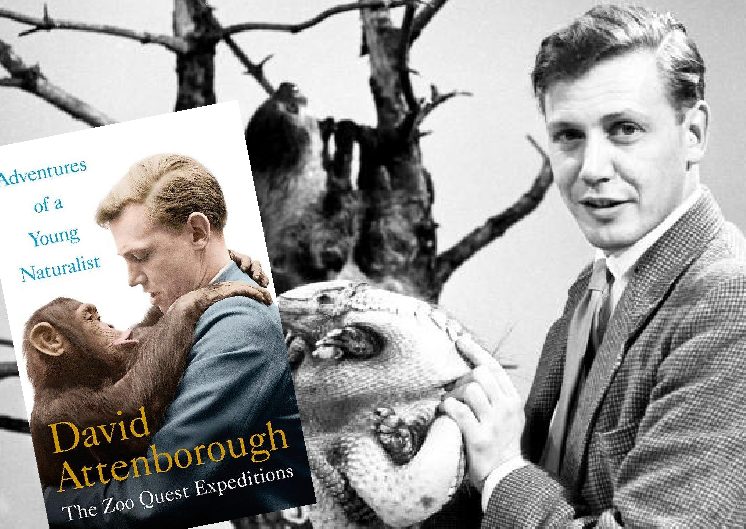It came as a bit of a shock to discover that David Attenborough once hunted wild animals although he was never a trophy hunter.
When he was a young man in the 1950’s it was seen as a good thing to locate and where possible to capture rare animals and bring them back home so the animal world could be mapped.
So he and his small team travelled to distant countries to bring back as many as they could find for the London zoo. These expeditions were filmed for the BBC for a TV series called Zoo Quest.
 Adventures of a Young Naturalist is based on the 3 books which accompanied the early episodes in the 1950’s and which Baby boomers might well have seen on their black and white TV’s.
Adventures of a Young Naturalist is based on the 3 books which accompanied the early episodes in the 1950’s and which Baby boomers might well have seen on their black and white TV’s.
“These days zoos don’t send out animal collectors on quests to bring them back alive. And quite right too.” Attenborough writes in the preface. “The natural world is under enough pressure as it is, without being robbed of its most beautiful, charismatic and rarest inhabitants.”
On their expeditions he and his small team often took mind-boggling risks, coped with almost unbearable heat, torrential rains, hordes of vicious biting pests and stinging insects and mechanical failures.
But he was young, he was adventurous and not easily rattled and makes light of being very hungry and extremely uncomfortable at times.
On their first journey to Guyana, they soon collected a giant ant eater, a caiman, a small anaconda, some fresh water turtles, capuchin monkeys, parakeets and macaws.
One day he climbed 40 feet up a tree to catch a sloth (about the size of a large sheep dog)
“It hung upside down and stared at me with an expression of ineffable sadness on its furry face.”
Unfortunately the food it needed for its survival would not be available in the zoo so they had to release it but not before keeping it for a few days so they could watch and film it.
Later on in this journey David’s sleep was disturbed by a vampire bat whose bite can cause the dreadful disease of paralytic rabies. Fortunately when he hurled his boot at it it took flight and disappeared through the window
Although most of the animals they collected travelled to London by boat David carried some “nice” spiders, scorpions and one or two snakes in sealed tins with tiny air holes so there would be no possibility of escape. And he tucked a little wild furry Coatimundi kitten inside his shirt. There is no way he would have got away with that kind of hand luggage nowadays!
On the second journey which was to Indonesia he and photographer Charles Lagus planned to travel widely through the islands to film not only the animals but also the people and their everyday life. Their ultimate aim was to seek out the Komodo dragon, one of the most remarkable creatures alive today and the world’s largest lizard.
They were ill prepared and struck problems with bureaucracy right from the start.
In the Javanese jungle Attenborough attempted to catch a 12 foot long python
“I caught up with it just before its head entered the bamboo. I snatched its tail and jerked it backwards. Infuriated by this indignity it turned on me, opened its mouth and drew its head back in a striking position, its black tongue flickering in and out.”
In Bali he writes fascinating accounts of local happenings like a tooth filing ceremony and a gruesome cockfight which he detested. In Borneo they adopt a baby bear and have an orangutan encounter which has a sad ending.
Then they were off on a journey to Komodo on a 25 foot prau .The captain was a shady character who appeared to have no idea where they are headed and it turns into a much more perilous journey than they could have imagined.

Their third journey was to Paraguay where they hoped to track down armadillos.
They travelled to a remote forest where they spent their first night in a store room where ‘huge brown cockroaches covered the walls in a glistening moving carpet and above them bats were flitting among the rafters.’
In the forest they encountered dense clouds of enchanting colourful butterflies and many tropical birds like trogons, birds the size of a cuckoo with scarlet chests and bristling moustaches around their beaks.
With the help of the villagers they collected a pair of rare Maximilian’s parrots, a young uracca jay, guans and a tegu lizard and five tiny parrot chicks.
They flew to a large cattle station in the northernmost province of Argentina. The first manager was an enthusiastic naturalist who had banned hunting in the vast area under his control. In this animal sanctuary we see the Attenborough we know so well. Not a hunter or collector, but simply entranced by the many rare birds he encounters there, and a keen observer of their habits.
Attenborough is a great story teller and The Young Naturalist is a fascinating account of the rare animal and birds he encountered. We are at risk of losing many of them because their habitat is increasingly being encroached upon. Hopefully his evocative descriptions will make readers more aware of their presence and the need to preserve these wild places.
Title: Adventures of a Young Naturalist. Author: David Attenborough. Publisher: Hachette. RRP $37.99 (paperback)
You can win a copy of ‘Adventures of a Young Naturalist’on GrownUps here.
Reviews by Lyn Potter
Parent and grandparent, Avid traveller, writer & passionate home cook










Join the Discussion
Type out your comment here:
You must be logged in to post a comment.